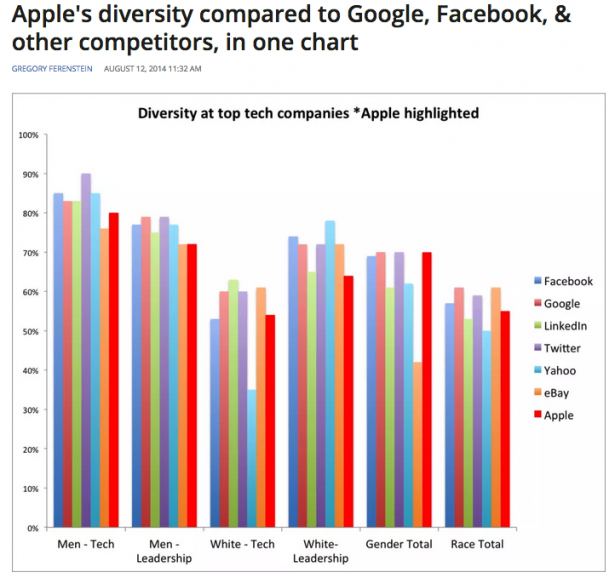DIVERSITY, TRANSPARENCY, AND ACCOUNTABILITY
/Diversity, Transparency, and Accountability
In my last post, I focused on the value of transparency for getting work done. Transparency can also have a broader effect. In a recent peer-reviewed study in the journal Organization Science, Emilio J. Castilla looked at merit-based rewards for almost 9,000 employees before and after changes related to transparency were implemented. Before accountability and transparency tactics were put in place, women and underrepresented groups had lower pay unexplained by differences in performance or position. After transparency and accountability practices were implemented, the gap went away. My take, supported by over 30 years of research in my field, is that given information, managers do the right thing. Without information, bias can creep in.
Diversity Context
This is timely, important research and especially interesting from my Silicon Valley location. The graph below shows 2014 data from the top tech companies. To their credit, they share this data voluntarily and it has focused attention on the problems for women and underrepresented groups. Apple recently reported their 2015 data, though with little change showing up yet. Slack, Pinterest, and Airbnb are all working with Paradigm, a startup focused on helping change these numbers.
I’m very interested in the internal accountability and transparency in these companies. Google has been in the spotlight around a spreadsheet Erica Baker, then a Google employee, created for Googlers to share information about their pay. The data raised questions about pay equality. She received great support from her peers, but not always from management. In later reports, Google told reporters that “employees are welcome to share information about salary if they choose.” What if such a spreadsheet were part of standard practice? Gender wage gaps are smaller in government and union settings where there is pay transparency as a matter of course.
It’s wonderful that these companies are sharing and taking action. (I’d also like to see data on age diversity - Microsoft provides theirs here, but guessing results look different in some of the other firms.) Internal, at least, accountability and transparency may be directions for them to consider. We can all take part by supporting young people interested in STEM fields and the organizations that give them solid backgrounds.
Tools to Support Transparency and Accountability
Technology may also play a role. Transparency and accountability are areas where technology can help us do the right thing. Technology supported task feedback helps us do work “right” and better. Process and outcome transparency (at the heart of the Castilla study) help us stay on the right side of just behavior. As internet enabled sensors, ubiquitous video, and internet-enabled work become the status quo, it’s easier to “work out loud” without extra effort and to hear the work of others as part of the ambient environment. Transparency doesn’t have to be hard and it can provide great value even as it supports our values.
More on Castilla’s Research
Castilla opens with a detailed review of accountability and transparency research. Building on Tetlock’s research in the 80s, Castilla describes accountable situations as those where you will have to justify your decisions and actions. Accountability provides motivation to make more analytical/careful decisions. As shown in some of Castilla’s earlier work, this can reduce bias in organizations. Transparency is about relevant, accessible, and accurate information. He splits both accountability and transparency into process and outcome categories -- which for those of you keeping score -- also ties the work nicely into research on how just people feel an organization is.








